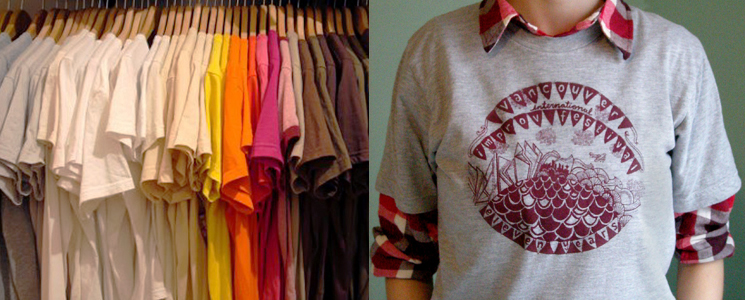
I recently packed up my childhood bedroom, under my bed I found three boxes of unworn t-shirts that I didn’t have the heart to throw away. I improvised from the time I was 14 to 23 and in those years I amassed 40 or so shirts, each one represents a great time with a troupe or at a festival. Despite how sentimental the shirts are, they were under my bed, not in my dresser. I do have a few improv shirts in my regular rotation, but the majority of the shirts never struck a chord with my fashion sense. Who can be blamed for making an unflattering improv shirt? What does improv look like anyway?
To some people improv looks like a dancing cartoon with a top hat, or Groucho nose and glasses or like those Comedy and Tragedy drama masks. None of these encompass the essence of improv, which is hard to pin down. Improv doesn’t have one cohesive visual element; its ever changing state is what makes it so magical. And yet, this state also makes it difficult to brand and promote. Well considered designs have the potential to work both as wearable endorsements and as community building tools.
Good design is important for the marketing of any business as it reflects the values of the company. In improv terms, if I see an improv shirt with a logo that hasn’t changed in 30 years, I might assume that this company performs old school games by the book. If I see an abstract design down one side of a colourful shirt, I might assume that this company produces experimental shows. Whatever type of improv a company is producing, it’s to their advantage to align their merchandise with their principles, thereby attracting the type of audience most suited to their shows.
It’s expensive to print t-shirts; you pay a large sum up front and hope that they will sell, or if you’re giving them away, that they’ll be worn often. They’re an investment and the risk/reward ratio applies here. The duo Scratch, Arlen Konopaki and Kevin Gillese, set an example for positive return on innovative merchandise. In 2006, they sold vintage men’s dress shirts (and later, suit jackets and dresses too) with their logo silkscreened in unlikely places. Each piece was unique and they sold like hot cakes. Furthermore, the dress shirts and jackets matched the ones Konopaki and Gillese wore in their act; the audience could be members of the club by wearing the garb. Seven years later and people are still wearing their merchandise.
It’s a bonus if an improv shirt is stylish, but we tend to keep them even if they aren’t. I’ve noticed that improv shirts act as informal resumes within the community. They tell everyone when and where you’ve performed, taught, studied or spectated. You can wear your experience across your chest, thereby saying “this represents me” or “I belong to this.” T-shirts serve a functional role within the community, like a military jacket with stripes and medals, they’re our uniforms.
My most meaningful experience with this has been with Canadian Improv Games (CIG) merchandise. I moved to Calgary for University when I was 18 and only knew a small handful of people. In my first week there I bumped into someone on the street who was wearing a CIG hoodie. I wasn’t afraid to approach this person and start a conversation because I read that logo as “I’m friendly.” Since then, this has happened to me in multiple cities.
I designed my first improv shirt when I was fourteen for my High School’s CIG team. Today, I’ve designed over two dozen shirts and have gradually learned what makes effective improv merchandise. There are technical challenges, like how to compose a design that is flattering on a variety of body types, which colours and images are unisex, how to design in only one or two colours (because silkscreening in multiple colours is expensive,) and how to not repeat yourself after so many designs on the same subject.
Being a part of the community has been essential to making relevant designs. Though, I quit performing in 2010 when I lost that urge to be on stage and wanted to spend more time in my art studio. I was making conceptual art, but it was through doing improv shirt designs for friends that I discovered the field of illustration. I hadn’t considered it as a career while I was in University but felt energized by the creative challenges these shirts provided. Long story short, I now work as a full-time illustrator and comic book artist.
Great apparel isn’t just about being trendy, it’s a way to include your audience, to document your own improv history, and a means of connecting the community. Merchandise design is a worthy investment and just like on stage, it pays to take risks.
Some of Meags' designs. (click image to enter slideshow)
· · ·





